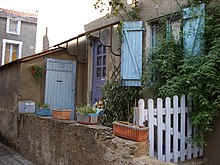Trentemoult
Trentemoult is an old fishing and seaman's village on the left bank of the Loire . It is incorporated into the municipality of Rezé , in the south of Nantes .
history
An island within islands
Trentemoult is located in an ancient cluster of islands: the islands of Rezé, bordered on the north by the Loire and on the south by the Seil. After this has silted up, the island status is over. The islands of Rezé are composed (from source to mouth) of the île des Chevaliers with its villages Haute-Ile and Basse-Ile, the hamlet of Norkiouse and finally the island of Trentemoult, which is separated from the rest of the islands by a small watercourse - Courtil-Brisset - is separated.
For the majority of the population, Trentemoult is often the entirety of the islands that were inhabited in earlier centuries by the other members of the actual island of Trentemoult.
According to tradition, the village got its name after war heroes who lived about 1000 years ago. After the siege of Nantes by the Normans in the 9th century, 30 brave men fought against the men from the north. The village should therefore have its name. Less epic but more believable is the story that Trentemoult comes from the words “trente moux”, that is, 30 hills.
Fishermen's Island
The Trentemousins, as the inhabitants of Trentemoults call themselves in French, typically lived almost exclusively from fishing in the Loire estuary until the beginning of the 19th century. You have benefited greatly from a fishing privilege introduced by the Duc of Brittany , John V , in 1397.
The fishermen of Trentemoult went out to fish on the Loire, in pairs to fish in the open sea, in groups of three in small , flat-bottomed boats . They ventured as far as La Rochelle and Lorient . In autumn they went to Mesquer Bay to fish for herring . The years 1756 and 1757 were unusually good , with a reported £ 300,000 surplus, a stroke of luck for the commune.
Island of the Captains
At the beginning of the 19th century the fishery was gradually given up and the inhabitants of Trentemoult devoted themselves to commercial transport shipping: coastal transport followed by ocean shipping . So Trentemoult was and remained one of the leading sources of officer recruitment for the commercial port of Nantes throughout the 19th century .
In parallel to the demand from captains from Trentemoult, shipyards developed on the islands , first on Trentemoult, then on Norkiouse due to lack of space: the most important were the shipyards of Chauvelon and Lemerle in the first half of the 19th century, Boju , Clergeau and Tillé in the second Half.
In the heyday of the shipyards it was briggs and three-masters that left the docks at Trentemoult.
The place
The traditional fishermen's houses, adapted to the floods of the Loire, were usually built with three floors. The first, which was intended for floods, was used as a cellar and storage room, the residential floor was on the second floor. The top floor was the warehouse, which was occasionally connected to the neighboring buildings in order to be able to visit the neighbors without having to go out into the street.
The stairs were generally attached to the outside so that you could get directly into the apartment floor even during floods. Sometimes there were also stairs inside. The construction of the embankments (Surcouf from 1850, Marcel Boissard between 1860 and 1888) has greatly reduced the risk of flooding. The last major floods to remember are those of 1910 and 1935.
In the second half of the 19th century, the captains, including Cape Horniers (Cape Horn circumnavigators), built bourgeois houses close to the old village with gardens filled with exotic plants that they found on their long journeys had.
Nowadays the fishing district with beautiful, historic and colorfully painted houses is a really worth seeing part of Nantes. The facades are very individual with historical and very characteristic paintwork. Many artists and bobos live in this new “in” area of Nantes .
movie theater
The filmmaker Jean-Loup Hubert shot The beautiful Lili (La rein blanche) here with Catherine Deneuve in 1991 . Claude Chabrol also shot the film The Bridesmaid (La demoiselle d'honneur) here in 2005 .
Trentemoult also inspires young filmmakers to make short films.
Ferry service
In 1887 the steamship named Roquio from Nantes docked for the first time on a quay in Trentemoult. This is the beginning of a company that worked until 1970.
Since 2005, two so-called navibuses (the Trentemoult and the Chantenay ) have been securing the connection between the Trentemoults pier and the center of Nantes , reminiscent of the times when the Roquio was the only way to cross the Loire .
gallery
Literature (french)
History (french)
- Vincent Bugeaud: Quand les bargers se font monnayeurs: une "aristocratie" chez les pêcheurs de l'estuaire de la Loire au XVIII e siècle . In: Annales de Bretagne , tome 112, 2005, n ° 4, pp.43-84.
- Vincent Bugeaud: Les bargers de Trentemoult et la pêche des harengs sur les côtes guérandaises au XVIII e siècle , in Les cahiers du Pays de Guérande, n ° 46, 2007, pp.79-85.
- Michel Kervarec: Rezé pendant la Révolution et l'Empire , ACL Editions, 1987.
- Michel Kervarec: Rezé au XIX e siècle , ACL Editions, 1987.
Novels (french)
- Georges Aubin, Les hommes en suroît , Flammarion, 1963.
- Marcelle Gaston-Martin, La Belle Trentemousine , Rieder, 1934.
Weblinks (French)
Coordinates: 47 ° 12 ′ N , 1 ° 35 ′ W



